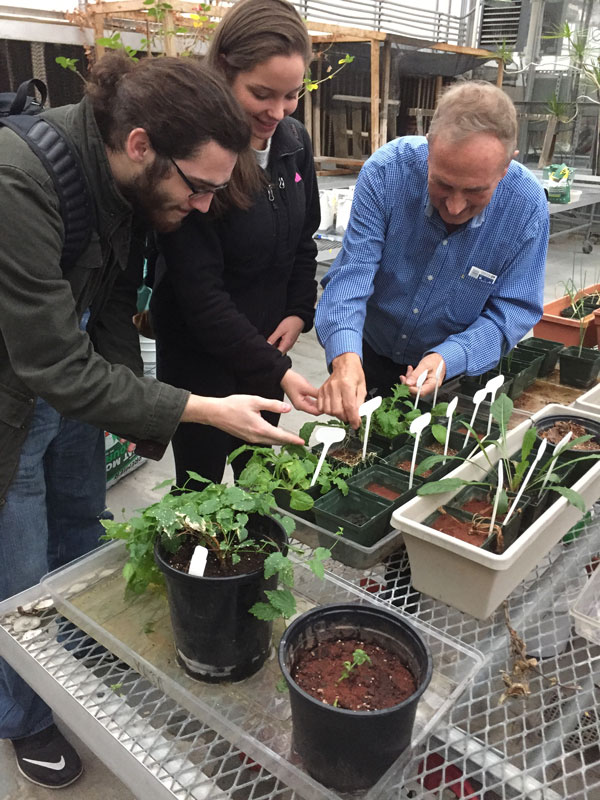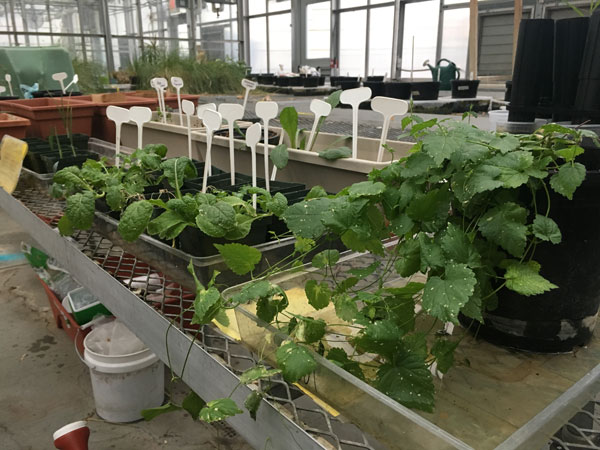Astrobiology students cultivated leafy greens, sweet potatoes, and even hops in simulated Martian dirt.

Villanova University
NASA and private entrepreneurs are pushing to land people on Mars within the next generation. To survive on Mars, colonists will need a lot of gear, not least of which is food. Since lugging food adds a lot of weight to spacecraft — and packaged food only retains its nutrients for so long, anyway — any would-be Martians will need to grow food on site in order to survive.
But conditions on the Red Planet are different than on Earth. The surface receives less than half the amount of sunlight that Earth does, and dust in the atmosphere can attenuate it even more. Due to the absence of an ozone layer, more ultraviolet radiation reaches the ground. As to the Martian surface itself, the dirt (technically “regolith”) is more iron-rich, particularly in iron oxides.
To see how terrestrial plants might fare in Martian soil, students at Villanova University last semester conducted the Red Thumbs Mars Garden Project. They obtained simulated Martian soil, made from volcanic basalts similar to those on Mars, and mixed it with other compounds to make it about 90% similar to Martian regolith.
The students focused on nutritious plants, including lettuce, kale, garlic, and potatoes, as well as hops (the business students were looking for inventive ways to make Martian greenhouse products marketable, professor Edward Guinan quipped during his talk January 12th at the American Astronomical Society meeting in Washington, D.C.). They then planted the seedlings in different concentrations of Martian soil in a campus greenhouse rigged for light levels on the Red Planet and let things unfold.
Despite hiccups in the pilot study (lack of greenhouse temperature control, students forgetting to water plants), several of the experimental foodstuffs grew fine in the Martian simulated dirt. Mixed greens such as lettuce and kale did well, but potatoes — the mainstay of protagonist Mark Watney in The Martian — did not. The clay-like Martian simulant was so thick that it crushed the growing taters, giving them no room to expand.
Overall, plants did much better when the students added filler such as coffee grounds to the Martian simulant, Guinan says. The filler fluffed the dirt up enough that water could percolate through and reach the roots.

Villanova University
One major difference between the Villanova project and real Martian soil is perchlorate (CClO4). Perchlorates abound in the uppermost layer of Martian regolith, potentially lowering the freezing temperature of water enough to explain some fleeting signs of liquid water activity on Mars.
But perchlorate is toxic to humans, causing thyroid problems and even death. Humans on the Red Planet might breathe it in from dust that infiltrated habitats, and growing food with it would be dangerous. “Matt Damon would have died,” Guinan said, referring to the Hollywood version of the novel. “It was never mentioned in the movie, you know — you don’t want to talk about things like that.”
Farmers on Mars will need to remove any perchlorate from the Martian soil before using it. One way is to rinse the soil, since perchlorate dissolves in water. Another, more enticing way is to use perchlorate-eating bacteria, which produce oxygen as a metabolic byproduct. That might protect the colonists from serious health problems while also bolstering their breathable air supply.
For those interested in doing similar projects with their students, Guinan recommends lettuce. “It grows fast, and you can eat it,” he says. “I ate the lettuce. I’m still here.”
You can watch a video about the project: "The Red Thumbs: Mars Garden Project". The class obtained their dirt from The Martian Garden.
 5
5









Comments
Anthony Barreiro
January 12, 2018 at 4:12 pm
Mars' atmosphere is 99% carbon dioxide, which plants would love, but atmospheric pressure is less than 1% of Earth's. Mean surface temperature is about -55 degrees C. It doesn't sound like these conditions were simulated in this study. Martian greenhouses would need to be airtight and highly pressurized, and heated.
Let's just keep sending robots. They can make direct use of the ambient sunlight, without needing any leafy green intermediaries.
You must be logged in to post a comment.
Rod
January 12, 2018 at 8:10 pm
Okay, somehow the proto-sun or solar nebula that created Earth, this soil problem apparently is not here killing humans on Earth but on Mars. However, the chemical is manufactured in industry.
https://en.wikipedia.org/wiki/Perchlorate
You must be logged in to post a comment.
Joe Slomka
January 14, 2018 at 2:00 pm
The fact that potatoes would not grow was made public shortly after the movie came out.
Scientists discovered this well after the book published and just before the movie debuted.
You must be logged in to post a comment.
Anthony Barreiro
January 16, 2018 at 2:40 pm
I guess that's why the genre is called science fiction. 😉
My criticisms of _The Martian_ aren't so much of its glaring scientific errors (starting with the fact that the Martian atmosphere is way too thin for anybody to ever be impaled by a radio antenna during a windstorm), but of the book as a work of fiction. The characters are all one-dimensional and lack any development over the course of the story. The plot is a monotonous series of catastrophes and improbable escapes. The novel as video game.
You must be logged in to post a comment.
Night Owl
January 16, 2018 at 7:23 pm
It would be far easier and less expensive to "terraform" the deserts here on Earth than to terraform Mars. Mars is far colder than Antarctica. No one lives at Antarctica except for a scientific community because it is too cold to live there. Mars has nothing to offer in return. It is a barren rock. Everything would have to be shipped there. There is no gold, no forests, or anything usable. Living on Mars is cost prohibitive and way more miserable than living in Antarctica. Forgetting to water plants could be a hazzard to survival.Life would be regimented by following procedures to the letter or one could be fatal. Sending robots to explore Mars is more acceptable than sending people. Robots don't require a constant supply of food.
You must be logged in to post a comment.
You must be logged in to post a comment.